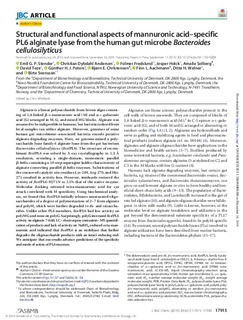| dc.contributor.author | Stender, E.G.P. | |
| dc.contributor.author | Andersen, C.D. | |
| dc.contributor.author | Fredslund, F. | |
| dc.contributor.author | Holck, J. | |
| dc.contributor.author | Solberg, Amalie | |
| dc.contributor.author | Teze, D. | |
| dc.contributor.author | Peters, G.H.J. | |
| dc.contributor.author | Christensen, Bjørn E. | |
| dc.contributor.author | Aachmann, Finn Lillelund | |
| dc.contributor.author | Welner, D.H. | |
| dc.contributor.author | Svensson, B. | |
| dc.date.accessioned | 2020-01-10T13:19:06Z | |
| dc.date.available | 2020-01-10T13:19:06Z | |
| dc.date.created | 2019-12-17T09:39:10Z | |
| dc.date.issued | 2019 | |
| dc.identifier.citation | Journal of Biological Chemistry. 2019, 294 17915-17930. | nb_NO |
| dc.identifier.issn | 0021-9258 | |
| dc.identifier.uri | http://hdl.handle.net/11250/2635729 | |
| dc.description.abstract | Alginate is a linear polysaccharide from brown algae consisting of 1,4-linked β-D-mannuronic acid (M) and α-L-guluronic acid (G) arranged in M, G, and mixed MG blocks. Alginate was assumed to be indigestible in humans, but bacteria isolated from fecal samples can utilize alginate. Moreover, genomes of some human gut microbiome–associated bacteria encode putative alginate-degrading enzymes. Here, we genome-mined a polysaccharide lyase family 6 alginate lyase from the gut bacterium Bacteroides cellulosilyticus (BcelPL6). The structure of recombinant BcelPL6 was solved by X-ray crystallography to 1.3 Å resolution, revealing a single-domain, monomeric parallel β-helix containing a 10-step asparagine ladder characteristic of alginate-converting parallel β-helix enzymes. Substitutions of the conserved catalytic site residues Lys-249, Arg-270, and His-271 resulted in activity loss. However, imidazole restored the activity of BcelPL6-H271N to 2.5% that of the native enzyme. Molecular docking oriented tetra-mannuronic acid for syn attack correlated with M specificity. Using biochemical analyses, we found that BcelPL6 initially releases unsaturated oligosaccharides of a degree of polymerization of 2–7 from alginate and polyM, which were further degraded to di- and trisaccharides. Unlike other PL6 members, BcelPL6 had low activity on polyMG and none on polyG. Surprisingly, polyG increased BcelPL6 activity on alginate 7-fold. LC–electrospray ionization–MS quantification of products and lack of activity on NaBH4-reduced octa-mannuronic acid indicated that BcelPL6 is an endolyase that further degrades the oligosaccharide products with an intact reducing end. We anticipate that our results advance predictions of the specificity and mode of action of PL6 enzymes. | nb_NO |
| dc.language.iso | eng | nb_NO |
| dc.publisher | American Society for Biochemistry and Molecular Biology | nb_NO |
| dc.rights | Navngivelse 4.0 Internasjonal | * |
| dc.rights.uri | http://creativecommons.org/licenses/by/4.0/deed.no | * |
| dc.title | Structural and functional aspects of mannuronic acid–specific PL6 alginate lyase from the human gut microbe Bacteroides cellulosilyticus | nb_NO |
| dc.type | Journal article | nb_NO |
| dc.type | Peer reviewed | nb_NO |
| dc.description.version | publishedVersion | nb_NO |
| dc.source.pagenumber | 17915-17930 | nb_NO |
| dc.source.volume | 294 | nb_NO |
| dc.source.journal | Journal of Biological Chemistry | nb_NO |
| dc.identifier.doi | 10.1074/jbc.RA119.010206 | |
| dc.identifier.cristin | 1761628 | |
| dc.description.localcode | Author’s Choice—Final version open access under the terms of the Creative Commons CC-BY license | nb_NO |
| cristin.unitcode | 194,66,15,0 | |
| cristin.unitname | Institutt for bioteknologi og matvitenskap | |
| cristin.ispublished | true | |
| cristin.fulltext | original | |
| cristin.qualitycode | 2 | |

